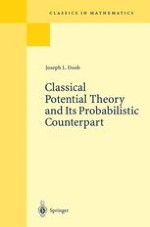2001 | OriginalPaper | Chapter
Brownian Motion on the Martin Space
Author : Joseph L. Doob
Published in: Classical Potential Theory and Its Probabilistic Counterpart
Publisher: Springer Berlin Heidelberg
Included in: Professional Book Archive
Activate our intelligent search to find suitable subject content or patents.
Select sections of text to find matching patents with Artificial Intelligence. powered by
Select sections of text to find additional relevant content using AI-assisted search. powered by
Let D be a connected Greenian subset of ℝN, let K be a Martin function for D, let h be a strictly positive superbarmonic function on D, and let {wξh(·), ℱξh(·)} be an h-Brownian motion in D from ξ with lifetime Sξh. For A a subset of D let SξhA and LξhA, respectively, be the hitting and last hitting times of A by wξh(·). According to Theorem l.XII.10, if h is harmonic, the Martin boundary is h-resolutive and μ D h(ξ, dζ) = K(ζ, ξ)M h (dζ)/h(ξ), where M h is the Martin representing measure of h corresponding to K. According to Theorem II.2, the left limit wξh(Sξh−) exists almost surely and has distribution μ D h(ξ, ·) supported (Section l.XII.7) by the minimal Martin boundary ∂1mD. In particular, if ζ is a minimal Martin boundary point and if h = K(ζ, ·), then μ D h(·, {ζ}) = 1; so wξh(Sξh−) = ζ almost surely. With this choice of h we shall sometimes write wξζ(·), SξζA, LξζA, respectively, for wξh(·), SξhA, LξhA.
